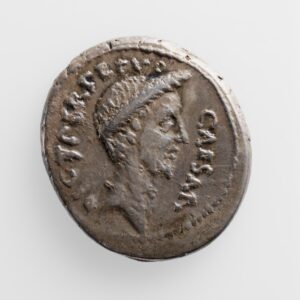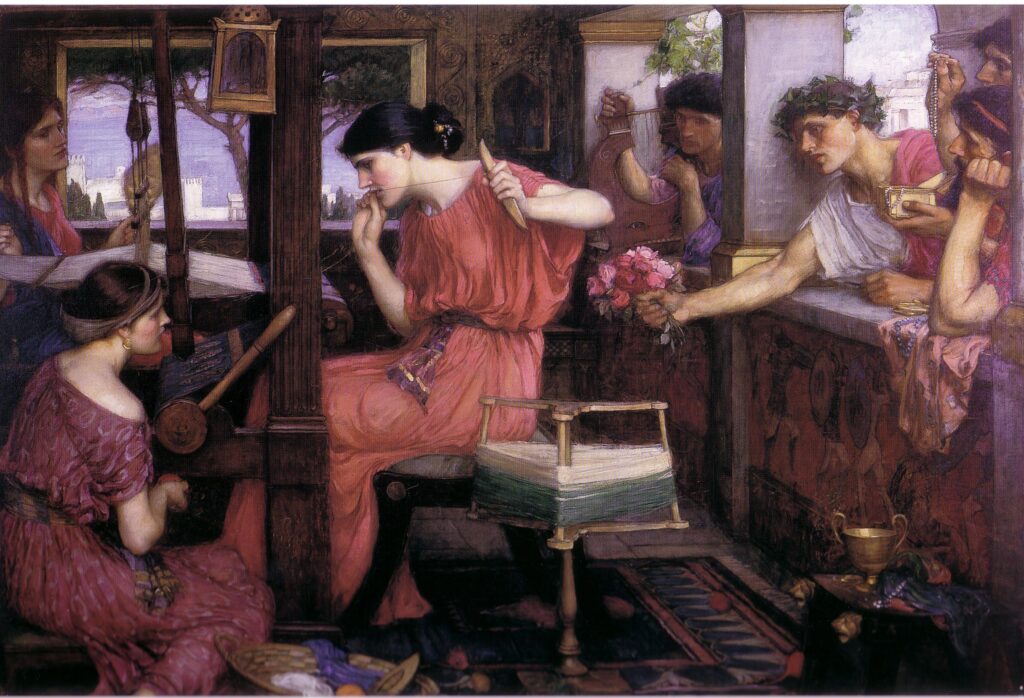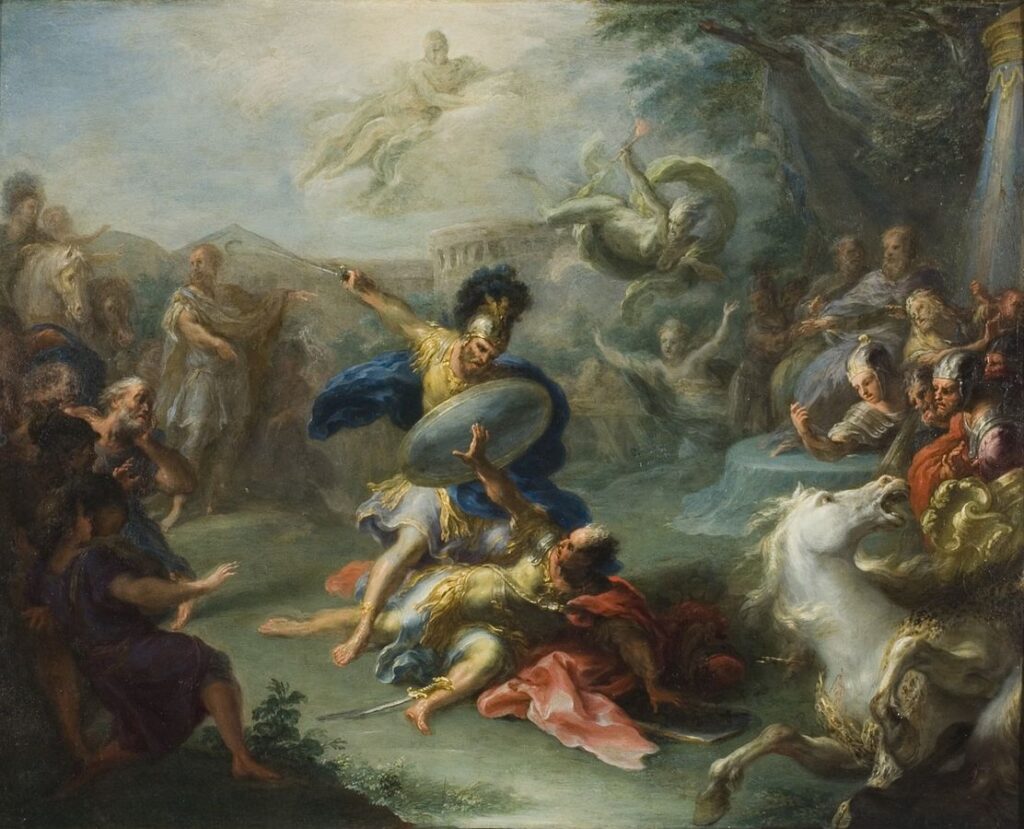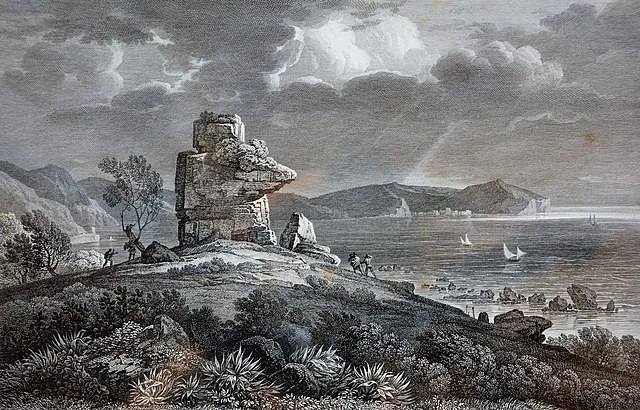Maia Lindsay (Dickinson ’28) reads Plutarch’s Lives of Caesar and Cicero and finds that, for all the flaws in the “great man” view of history, stories like those told by Plutarch do have some merit. They show what a single person is capable of, for good or for ill, and remind us that we’ll never be remembered for all the things we don’t do.
In Homer’s Iliad, the warriors and women of the tale inhabit a world practically unrecognizable to us today, one where rivers talk, wealth is measured in tripods, and claiming descent from a god is the equivalent of having the last name Smith. These people are not even physically like us, we are told – they are greater and stronger than we will ever be. In a typical passage, the warrior Ajax easily hurls a stone “so enormous that a man could scarcely lift it, even with both hands, even a very sturdy, strong young man – of modern times.” (Iliad 12.468–71).

It might be tempting to think of the men of Plutarch’s Lives in the same way as Homer’s warriors: remote, mythologized, and larger than life. The names of Caesar and Cicero have remained so familiar to us over the years that their names have practically outlasted their humanity. Unlike some of Homer’s heroes, however, these men were not half-god. And quotes about history repeating itself aside, human nature has not changed all that much in 2,000 years. Plutarch wrote his Lives – biographies of the greats of the ancient world – to record history, but also to pass down the lessons that could be learned from others’ successes, and perhaps just as importantly, failures. Two men who were overtaken by ambition and died by murder may not be the role models we seek in the modern age, but we can still find questions (and answers) in Plutarch’s text that resonate with us today.
Can being too trusting of others be a weakness?
Any discussion of misplaced trust in ancient Rome should probably begin with one of the most famous betrayals in history, immortalized for us today by the words, Et tu, Brute? (Shakespeare, Jul. Caes. 3.1 85). While Plutarch’s Caesar does not speak, the betrayal is hardly less dramatic: “Some say that Caesar fought back against all the rest, darting this way and that to avoid the blows and crying out for help, but when he saw that Brutus had drawn his dagger, he covered his head with his toga and sank down to the ground.” (Plut. Caes. 66). We cannot know whether Caesar actually exclaimed something or played dead like a possum, but in each variation of this story, one thing is the same: of all the betrayals Caesar faced on that day, the knife of Brutus was the one he couldn’t endure.
“Fate, however, seems to be not so much unexpected as unavoidable,” Plutarch remarks as he begins his account of Caesar’s assassination on the Ides of March (Caes. 63). One does not have to believe in the ancient understanding of fate to understand the message: someone with eyes could have seen what was to come. Brutus had not begun as a great ally of Caesar, and his rise to be “a person in whom Caesar had particular trust” (62) was fast and unlikely.
Four years before Caesar’s assassination, Brutus had been among the army facing down Caesar at the Battle of Pharsalus. After a victory that would prove to decide the civil war, Caesar walked into the enemy camp with the lives of many prominent Romans in his hands. As throughout the war, however, he chose not to be a vengeful victor. He freely gave out pardons that day, including to the man who would one day end his life. Reportedly, he even sought him out especially: “It is said that Caesar was very distressed when Brutus was not to be found, and that he was particularly delighted when, in the end, he was brought to him alive and well.” (46)
Forward several years, to the end of the war in 45 BCE, and Caesar’s mercy proved to extend beyond sparing lives. In the aftermath of the U.S. civil war, it’s hard to imagine Ulysses S. Grant appointing former Confederate generals to his Cabinet, but that was what Caesar chose to do. Brutus and another former adversary Cassius were made praetors that year, and Brutus was on track to be consul in three years, the highest office in the old Roman hierarchy (62).
Caesar apparently desperately wanted Brutus to be on his side and allowed that want to deceive him as to the reality. Indeed, Brutus did resist efforts to pull him into a plot at first, torn by all he owed to Caesar – his life, most of all – but in the end, he had the quality the Romans were most looking for: “[h]e was thought to be, on his father’s side, a descendant of the Brutus who had abolished the monarchy.” (62) They needed a king-killer, and here was their man. By the time Caesar walked into the senate on the Ides of March, those who were inciting Brutus against him had won, and he was none the wiser.
Cicero, too, experienced his share of betrayals. The politician and demagogue Clodius appears as a dark smudge across a number of Plutarch’s Lives, notably causing Caesar’s divorce from his second wife, Pompeia (Caes. 10). Clodius was, in fact, a friend of Cicero’s, but when Clodius went on trial for “perjury, fraud, bribing the people and seductions of women,” Cicero abandoned him and testified against him (Cic. 29). Clodius won acquittal anyway (likely through bribery), but he did not forgive the betrayal. Once he won election to a tribunate, he had a position from which to act and began his mission to bring Cicero down. Cicero, seeing that the winds were against him, sought a way to get out of Rome until Clodius’ term finished. Before he could skip town, however, Clodius intervened. He wanted a reconciliation, or so he claimed: “[he] made the most friendly remarks about him, giving the impression that he[…] had nothing against him except a few minor complaints which one friend might make of another.” (30) Cicero fell for the bait, and he declined his post on Caesar’s campaign to Gaul. Too late, he realized the trap laid for him. Clodius made Cicero’s life miserable in Rome before driving him into exile for real, with an “edict that he should be refused fire and water and that no man should give him shelter within 500 miles of Italy.” (32) Cicero managed to return to Italy after 16 months, but one would expect that a lesson had been learned.
Instead, one might say that Cicero laid the second trap for himself. In the aftermath of Caesar’s assassination, the dictator’s right-hand man Antony was on the ascendant, who was wary of Cicero and alarmed by his continued influence in Rome. Reassured by the election of the sympathetic consuls Hirtius and Pansa, however, Cicero chose once again not to leave Rome when it would have been wiser for him to do so (43). Then when Caesar’s heir and Antony’s natural competitor Octavian arrived in Rome, Cicero saw his chance. He could oppose Antony and wield this young man’s power to his own advantage with a simple bargain: “Cicero was to use his powers of oratory and political influence on Caesar’s behalf in the senate and before the people, and Caesar with his wealth and armed forces was to guarantee Cicero’s security.” (44) The deal worked – for a time. Once Cicero had helped Octavian win the consulship, however, he soon became disposable. He had “allowed himself to be carried away by the words of youth,” and now he realized, too late, “that he had ruined himself and betrayed the liberty of his country.” (46)
Octavian now ran into the arms of his former enemy Antony, as well as Lepidus, and the three together “divided the government[…] as though it were a piece of property.” (46) In their three-day conference near Bononia, they drafted the infamous proscriptions, with “more than 200 men who were to be put to death.” (46) Antony’s very first demand, unsurprisingly, was for the death of Cicero. Like Brutus before him, Octavian initially resisted, but when he weakened on the third day Cicero’s fate was sealed. “[A]ll considerations of humanity,” Plutarch says, “were swept aside by their rage and fury.” (46) Even when Cicero got wind of the proscriptions, however, he seemed reluctant to believe it of the young man who had reportedly called him “father.” (45) Describing his hesitation to flee and fateful delays, Plutarch wonders if “he had not yet entirely lost his faith in Caesar.” (47) Whatever faith he had, it proved fatal.
I would like to be able to disagree with the lesson imparted here. No one wants to be cynical, and unwilling to trust their fellow humans. However, as I myself have made the error of giving back my trust to a friend who had not earned it back, I can very well understand the risks. I have since learned caution, and I think that is a good thing.
On the other hand, trust is necessary to any sort of compromise, without which no government or society can properly function. Both Caesar and Cicero achieved much of what they did by acting with moderation and being open to cooperation with their political adversaries. A middle course, then, must be necessary: trust others, but be wary of those who have not actually done anything to earn the trust placed in them. The histories of Brutus, Clodius, and Octavian all should have been cause for reasonable doubt – however, as I can attest, this is easier said from a distance. Sometimes, the only way to learn is through mistakes – even fatal ones.
When is it right to give up freedom for stability?
Fans of Jean-Jacques Rousseau or other Enlightenment-era thinkers may be familiar with the concept of the social contract, the founding principle of governments, whereby individuals give up some part of their freedom in exchange for the protection of laws.
More than a millennium separated Rousseau from Plutarch, but the recurrence of this question goes to show just how fundamental it has been for human history. Plutarch was not concerned with the origin of government, however, but with the nature of government. Rome, unlike almost every other civilization before or after up to the last 200 years, was not a monarchy. Ask any Roman, and they’d tell you they very much wanted to keep it that way. Rome was not free from the institution of absolute power, however, as within their constitution they had a system in place for times of crisis, where a “dictator” would be appointed for a short period (usually six months) and bring the stability of one-man rule until things settled down.
The general Roman answer, then, was that freedom sometimes had to be ceded in the short term in the interest of stability, but with the expectation that constitutional norms would be restored in time. The problem, as Rome crept ever closer to civil war, was that adherence to constitutional norms was growing increasingly rare. Even elections, the very foundation of the system, were failing, as “candidates for office quite shamelessly bribed the electorate, actually counting out the money in public, and the people who had received the bribes went down to the forum not so much to vote for their benefactors as to fight for them with bows and arrows and swords and slings.” (Caes. 28)
The current governmental system was clearly nearing collapse, and so the question at that point was whether the ruling class would be willing to sacrifice its own power to save it. It was not clear that anyone appointed dictator at that point would give back power once it was handed to him – Rome’s powerful men had grown too powerful to trust in their goodwill. But “intelligent people,” as Plutarch reports, “could only be thankful if, after such a mad and stormy period, things ended in nothing worse than a monarchy.” (28) Many eyes were on the great general Pompey, who, Plutarch claims, “put on a show of declining the honor, but in fact did more than anyone else to get himself made dictator.” (28) Cato, one of the most ferocious republicans in the senate, sought a slightly more palatable solution and successfully had Pompey appointed sole consul instead, hoping that would be enough to hold Rome together without the senate having to abandon its power (28).
It was not. One powerful man might be a recipe for peace, but two is not, and Caesar was still on the loose. Civil war arrived when the senate was unable to produce an agreement for mutual disarmament between Pompey and Caesar (30). Idealism was rapidly abandoned as everyone was driven into the arms of one would-be dictator or another: Cicero, who reluctantly took the side of Pompey, “said he would rather follow in Caesar’s triumphal procession, if only matters could be settled satisfactorily.” (Cic. 37) And when the war ended with Caesar’s victory, the war-weary Romans largely “accepted the bit” (Caes. 57) – if this was what was necessary to have peace, they would take it. The man might be different, but their logic was the same as it had been with Pompey: “The rule of one man would give them, they thought, a respite from the miseries of the civil wars, and so they appointed him dictator for life.” (57)
As it happened, the civil wars ended not with Caesar but with his heir, Octavian, who was first to claim the imperial throne, and thus brought about the final demise of the republic. Rome was secure again, if not quite as free as they had been.
The imperial experiment worked out extremely well for Rome – the nation that had been on the verge of collapse went on to survive for another 500 years. (If you count the Byzantine Empire as the successor to Rome, you could even argue it lasted another 1500 years.) Rome has not been the only nation to make this bargain, either. England had an 11-year republican experiment after its own civil war, but as soon as the government fell into disarray, the people invited their monarch back. Nevertheless, the abandonment of a free government for absolute rule by an individual is a sacrifice that many people today (including myself) would not applaud. Can there be a lesson here, then? Perhaps. In Plutarch’s world, those who were willing to accept this compromise succeeded. We can decide whether they succeed in ours.
Can justifiable fear be worthwhile?
For this question, the two figures of Caesar and Cicero offer perfect counterpoints to each other, as they are each shown to have very different relationships to fear.
According to Plutarch, Cicero’s “reputation for courage among the people of Rome was not in any case a very high one.” (Cic. 19) Plutarch describes a particular incident where Cicero was serving as the defense for a man named Milo, who was being prosecuted for a prominent murder (35). Under directions from the senate to ensure no disturbances happened at the trial, the general Pompey had his soldiers posted around the forum the night before the trial. Milo knew that Cicero “lacked courage at the sight of armed men,” (35) and so he convinced him to be carried in on a litter so he would not see them and lose his confidence to speak. He spotted them anyway as he emerged from the litter, and, as Plutarch reports, “his body shook, his voice faltered and he could scarcely begin his speech.” (35)
On another occasion, when elections were being held during Cicero’s term in office, he showed up to preside wearing a breastplate under his clothes out of the fear of electoral violence (14). Plutarch even reports, shockingly for one with such a great reputation as an orator, that Cicero was “always timid at the beginning of a speech and in many trials scarcely stopped quivering and trembling even when he had really got going and was at the height of his eloquence.” (35)
Finally, there are the events leading up to Cicero’s death. After the news of the proscriptions reached him, Cicero wasted days in indecision, moving to flee, then retreating, and then turning to flee again. Plutarch suggests that some of this, or perhaps all of it, may have been motivated by fear. The night before what was to be his final move, to his estate at Caieta, Plutarch tells us that “he passed a night with his mind full of terrible thoughts and desperate plans. He actually decided to go secretly to Caesar’s home and kill himself there on the hearthstone, so as to bring a curse from Heaven upon him; but fear, the fear of torture, turned him from this course also.” (47) The next morning, he left for good, but it would be too late.
For most of his life, Caesar was the complete reverse of Cicero. He seemed to hold very little fear for his life, or at least was able to control it well. The Life of Caesar is full of examples of his daring on the battlefield, where “he showed that there was no danger which he was not willing to face.” (Caes. 17) He did not hesitate to fight at the frontline of battle alongside his men, on foot, putting himself in as much peril as any of them. The most dramatic example of this is from a battle against the Nervii tribe in Gaul, where “[i]n all probability the Romans would have been destroyed to the last man if Caesar himself had not snatched up a shield, forced his way through to the front of the fighting, and hurled himself on the natives; and if the tenth legion, seeing his danger, had not charged down from the high ground and cut their way through the enemy’s ranks.” (20) In civilian life and government he behaved no differently, and indeed “when Caesar’s friends advised him to have a bodyguard, many of them volunteering to serve in it themselves, Caesar refused to have anything to do with it.” (57)
The contrast between the two men could not be greater, then. However, the Life of Cicero shows Cicero acting courageously exactly once, and that was when the game was up and his death was all but certain. When his designated assassins caught up to him, Plutarch tells us that “[h]e himself, in that characteristic posture of his, with his chin resting on his left hand, looked steadfastly at his murderers.” (Cic. 48) Contrast this with Caesar, who Plutarch describes as spending his lasts moments like a cornered wild animal, “darting this way and that to avoid the blows and crying out for help.” (Caes. 66) Whatever “cowardice” Cicero may have shown in the rest of his life, he made up for it in the dignity of his death.
Still, we end where we began: in the end, both men were murdered. And that, I believe, is precisely the point. Cicero achieved no net gain for being more cautious with his life than Caesar. Caesar’s lack of a guard did not save his life, but neither did Cicero’s hidden breastplate save his. For every outcome that we can prepare for, there are ten more that we can’t.
I don’t believe this should be taken as an argument for anyone to stop wearing their seatbelts or bike helmets, but it’s certainly a reminder that sometimes living in fear only takes away from our enjoyment of the years that we do have. It’s certainly a lesson that I myself would do well to learn. As a younger person, I would have quoted a fictional character here: “My philosophy is that worrying means you suffer twice.” (Fantastic Beasts) However, I think Caesar, through Plutarch, expresses it just as well: “It was better, he said, to die once than to always live in the fear of death.” (Plut. Caes. 57)
That quote, I believe, sums up the argument I would make for every one of the questions I have discussed here. Trusting others might turn around to hurt us, and we should show some caution in who we offer our trust to, but we all have to trust someone, sometime, for society to function. The rule of a single person with absolute power may offer temporary stability, but it requires compromising a hundred other things for the sake of perceived security. Fear can be a useful mechanism for keeping ourselves safe, but no amount of worry will save us in the end.
What then? We focus on the actions that matter, not the consequences that we risk. If death is inevitable, we shouldn’t waste our lives trying fruitlessly to stop it. Caesar and Cicero did not make it into the pages of Plutarch’s Lives for doing otherwise. They didn’t always make the right choices, but they made them. They didn’t always do the right things, but they did them. A Caesar who did not cross the Rubicon would not be a Caesar. A Cicero who didn’t jeopardize his life working against Antony would not be a Cicero.
For all the flaws in the “great men” view of history, stories like those told by Plutarch do have some merit. They remind us what a single person is capable of, for good or for ill. They remind us that we’ll never be remembered for all the things we don’t do.
So, get out there and do something.








